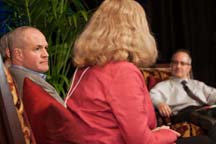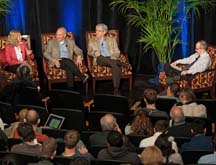Thirty years ago, the future lay in programming computers. Today, it's programming cells.
That was the message of panelists at a session in Stanley Hall auditorium at the University of California Berkeley titled “Programming Life: the revolutionary potential of synthetic biology.” Co-presented by UCB's Synthetic Biology Engineering Research Center (SynBERC) and Discover magazine, the panels brought together a dozen of synthetic biology's pioneers as well as ethicists focused on the societal impact of the technology.
Keynote speaker Juan Enriquez, co-founder of the company Synthetic Genomics, compared the digital revolution spawned by thinking of information as a string of ones and zeros to the coming synthetic biology revolution, premised on thinking about life as a mix of interchangeable parts — genes and gene networks — that can be learned and manipulated like any language. At the moment, this genetic manipulation focuses on altering bacteria and yeast to produce products they wouldn't normally make, such as fuels or drugs. “To do with biology what you would do if you were designing a piece of software,” according to moderator Corey Powell, editor at large of Discover .

Jay Keasling (left), director of SynBERC, and moderator Corey Powell of Discover listen as Monsanto scientist Virginia Ursin explains the company's interest in synthetic biology . A Christine Fu photo. Jay Keasling, a UC Berkeley chemical engineer, director of SynBERC, has been a key player in developing the field of synthetic biology over the last decade. He expressed excitement about the release next month by the pharmaceutical company sanofi aventis of a synthetic version of artemsinin, “the world's best antimalarial drug,” he said. Sparked by discoveries in Keasling's lab more than a decade ago, the drug is produced by engineered yeast and will be the first product from synthetic biology to reach the market.
Keasling is also CEO of the Joint BioEnergy Institute (www.jbei.org), and is now focused on engineering microbes to turn a billion tons of biomass that go unused in the U.S each year into fuel, perhaps producing roughly a third of the U.S. need.
But other advances are on the horizon, he said, such as engineering new materials and “green” replacements for all the products now made from petroleum.

Ursin, Keasling and Steve Evans of Dow AgroSciences discuss the economic potential of synthetic biology with Corey Powell. (A Christine Fu photo.)
Virginia Ursin, Technology Prospecting Lead and Science Fellow at Monsanto Corp., noted that industry sees synthetic biology's triumphs as being 10 to 20 years down the road. “Engineering (microbes) to increase their impact on (plant) health or protection against disease is probably going to be one of the nearer term impacts of synthetic biology” she said, and the field could have a revolutionary impact on agriculture.
But, Enriquez noted, the implications of being able to engineer cells go deeper. “This isn't just about economic growth, this is also about where we are going as a human species,” he said. Humans will no longer merely adapt to or adopt the environment, but “begin to understand how life is written, how life is coded, how life is copied, and how you can rewrite life.”
Drew Endy, a bioengineering professor at Stanford, summed up his hopes for synthetic biology. “What I would like to imagine as a longer-term encompassing vision is that humanity figured out how to reinvent the manufacturing of the things we need so that we can do it in partnership with nature; not to replace nature, but to dance better with it in sustaining what it means to be a flourishing human civilization.”
Based on an article by Robert Sanders of UC Berkeley. You can learn more about the Synthetic Biology Engineering Research Center at www.synberc.org.
Advertisement





